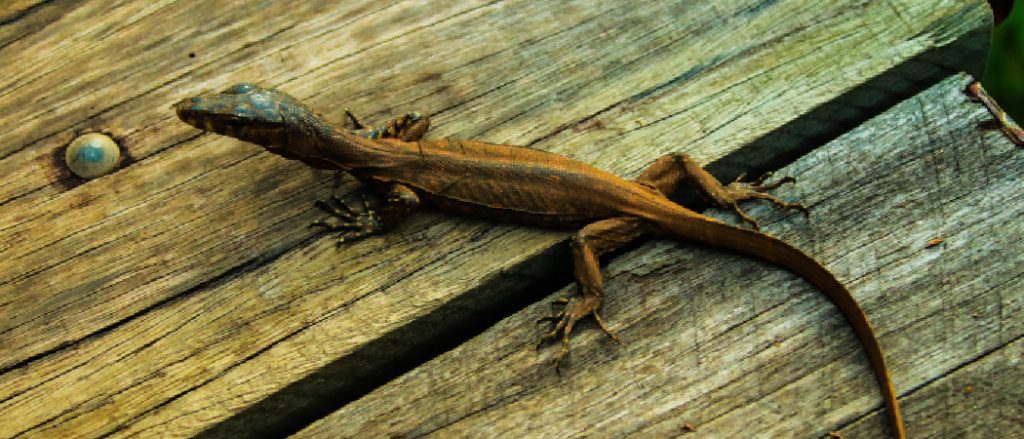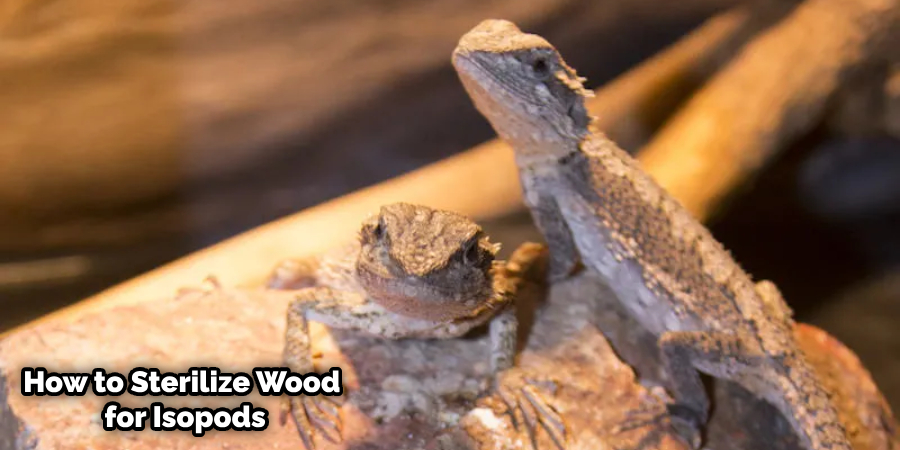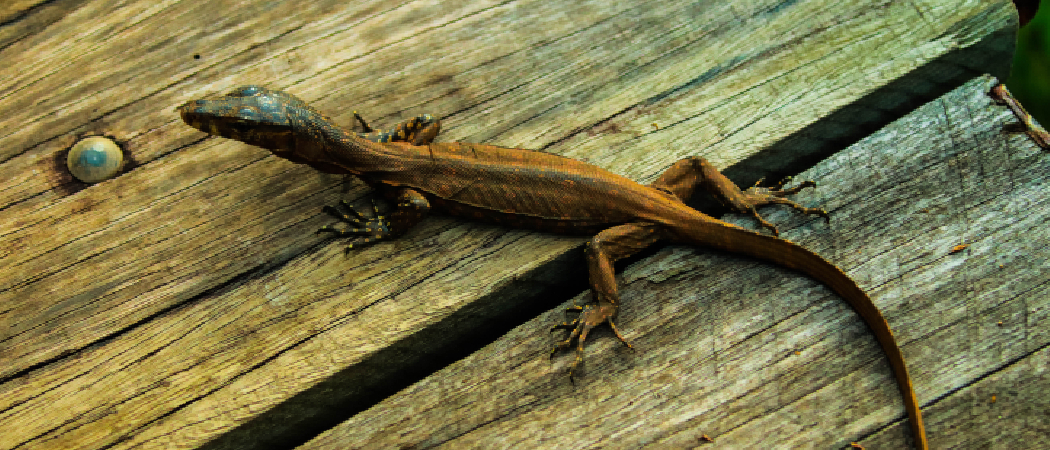The best way to sanitize wood for reptiles is to first scrub it with soapy water and a stiff brush. Be sure to use a mild soap, such as dish detergent or unscented laundry detergent, as harsh chemicals can be harmful to the reptile. Once the wood has been scrubbed down, rinse it with clean water and then let it air dry completely in a well-ventilated area away from direct sunlight. Wooden enclosures make an excellent habitat for reptiles, providing a natural and aesthetically pleasing environment. However, it’s crucial to ensure that the wood is properly sanitized to create a safe and healthy living space for your scaly friend. Reptiles are sensitive creatures, and their well-being depends heavily on the cleanliness and hygiene of their habitat. In this comprehensive guide, we will walk you through the essential steps to effectively sanitize wood for reptiles, ensuring a comfortable and secure environment for your pet.

After that, soak the wood in either full-strength white vinegar or 3% hydrogen peroxide solution for 10 minutes before rinsing again with clean water and letting it air dry completely once more. Finally, bake the wood at 250°F for 30 minutes prior to using it as part of your reptile’s enclosure. This will kill any remaining bacteria and ensure the safety of your pet.
- Remove any dirt, debris, and old substrate: Use a vacuum cleaner or broom to remove any dirt and debris from the surface of the wood
- If there is an existing substrate, such as sawdust or sand, it should also be removed before sanitizing
- Clean with soap and water: Using an all-purpose cleaner and hot water, scrub down the wood to remove any built-up oils, grease, or other contaminants that may be present on its surface
- Rinse with clean water: After cleaning the wood with soap and water, thoroughly rinse it off using clean running water to ensure all traces of soap residue are removed
- Dry completely: Once you have finished rinsing off the wood, allow it to dry completely before moving on to the next step in the sanitizing process, which is disinfection/sterilization
- 5 Disinfect/Sterilize Wood Surface: For this purpose, you can use either a bleach solution (mix 1 part bleach to 10 parts water) or hydrogen peroxide (mix 1 part hydrogen peroxide 3% solution with two parts distilled white vinegar)
- Dip a cloth into your chosen solution, then apply generously over the entire wooden surface (avoid contact between skin and solutions)
- Allow 5 minutes for the disinfectant/sterilizer to work, then wipe off using another damp cloth, followed by wiping dry using paper towels.
If you went to know more about how to sanitize wood for reptiles, keep reading!
How to Sterilize Wood for Reptiles
Understanding the Importance of Sanitization:
Before diving into the sanitization process, it’s essential to understand why it is crucial for your reptile’s health. Sanitizing wood helps eliminate harmful bacteria, parasites, and fungi that could pose a threat to your pet. In the wild, reptiles have the freedom to roam and choose their surroundings. In captivity, it’s your responsibility to replicate a similar, if not safer, environment for them.
How Do You Sanitize Large Wood for Reptiles?
Sanitizing large wood for reptiles is an important part of keeping them healthy and safe. The most effective way to sanitize large wood is by boiling it in water for 25 minutes, as this will kill any organisms that may be living on the surface. It’s also a good idea to soak the wood overnight in a 10% bleach solution before boiling it, and then rinse off all residue with clean water after boiling.
Additionally, you can use products specifically designed for disinfecting surfaces, like reptile-safe disinfectant sprays or wipes which are available at pet stores. Make sure to dry off the item completely once done cleaning/sanitizing it so there’s no chance of bacteria lingering on the surface.
How Do You Sanitize Driftwood for a Reptile Tank?
When sanitizing driftwood for a reptile tank, it is important to first choose driftwood that has been properly dried and stored. If you are collecting the wood from outdoors, make sure to thoroughly scrub off any dirt or debris before bringing it into the home. Once the wood is clean, boil it in water for at least 10 minutes to kill bacteria and other organisms living on its surface.
After boiling, allow the wood to cool completely before adding it to your reptile’s enclosure. Additionally, you can soak the driftwood in a diluted bleach solution (3 tablespoons of chlorine bleach per gallon of water) for 30 minutes before rinsing it with clean water and allowing it to dry completely prior to use in your tank.
How Do You Disinfect Bark for Reptiles?
When disinfecting bark for reptiles, you’ll want to start by removing all of the old bark and cleaning out the enclosure. Then rinse off any leftover dirt or debris from the new bark with warm water. You should also make sure that you’ve removed any insects or other pests that may be living in it as well.
Once your bark is clean, you can use a reptile-safe disinfectant solution such as F10SC Veterinary Disinfectant to kill any remaining bacteria and fungi on its surface. Simply spray down the substrate with the solution until completely saturated and allow it to dry before putting it into your reptile’s habitat. It is important to remember not to reuse disinfected substrate without prior thorough cleaning again with hot water first!
Choosing the Right Type of Wood:
Not all wood types are suitable for reptile enclosures. Certain woods can harbor harmful organisms or release toxins, endangering your pet. Opt for non-toxic hardwoods such as oak, maple, or hickory. These woods are dense and less likely to mold, making them ideal choices for reptile habitats.
Step 1: Thorough Cleaning
Start by cleaning the wood thoroughly to remove any visible dirt, debris, or contaminants. Use a soft brush to scrub the surface, ensuring you reach all the nooks and crannies. Remove any loose bark or wood pieces that might pose a choking hazard to your reptile.
Step 2: Sanding
After cleaning, sand the wood to remove rough edges and create a smooth surface. Sanding not only enhances the aesthetic appeal but also makes it easier to disinfect the wood effectively. Use fine-grit sandpaper to avoid splinters and ensure a polished finish.
Step 3: Heat Treatment
One of the most effective ways to sanitize wood is through heat treatment. Bake the wood pieces in an oven at a temperature of 250°F (121°C) for at least 30 minutes. This process kills bacteria, fungi, and parasites present in the wood, ensuring a safe habitat for your reptile. Always monitor the wood closely during heat treatment to prevent it from catching fire.
Step 4: Freezing
Freezing is another method to kill parasites and their eggs. Place the wood in a freezer and leave it for a minimum of 72 hours. Extreme cold temperatures eliminate most pests, making the wood safe for your reptile companion.
Step 5: Boiling
Boiling the wood is effective for smaller pieces that can fit into a pot. Boil the wood for at least 1-2 hours to kill bacteria and parasites. Regularly change the water to ensure thorough sanitization.
Step 6: Natural Disinfectants
Natural disinfectants like white vinegar or a diluted bleach solution can be used for sanitizing wood. Create a mixture of one part bleach to ten parts water and soak the wood in it for 15-20 minutes. Rinse the wood thoroughly with clean water afterward to remove any residual bleach. Alternatively, you can use a vinegar solution by mixing equal parts of water and white vinegar. Soak the wood for a few hours and then rinse it thoroughly.
Step 7: Drying
After sanitization, allow the wood to dry completely before introducing it into the reptile enclosure. Proper drying prevents the growth of mold and ensures the wood remains hygienic for a longer period. Place the wood in a well-ventilated area and let it air dry for several days.
Step 8: Monitoring and Maintenance
Regular monitoring and maintenance are essential to keep the wood in your reptile’s enclosure sanitized. Perform routine checks for any signs of mold, pests, or wear and tear. Remove and sanitize any affected wood immediately to prevent the spread of contaminants.
How Do You Disinfect Reptile Decor?
When disinfecting reptile decor, the most important factor to consider is what type of material it’s made from, for example, plastic and ceramic can be scrubbed with a bleach solution (1 part bleach to 10 parts water), while wood should be wiped down with an alcohol-based cleaner or diluted vinegar solution. Be sure to rinse all materials thoroughly after cleaning and allow plenty of time for everything to dry before returning it back to your pet’s habitat.
Additionally, UV sterilizers are also available, which use ultraviolet light to kill bacteria and other organisms on surfaces – these are particularly useful for hard-to-reach places like decorations in terrariums or tanks.

Credit: www.youtube.com
How to Sanitize Sticks for Reptiles in Oven?
Sanitizing your sticks for reptiles in an oven is a simple and effective way to keep them clean. To do so, preheat the oven to 350 degrees Fahrenheit and spread out the sticks on an aluminum foil-covered baking sheet. Bake for 30 minutes, then remove from the oven and allow them to cool completely before using.
This will kill any bacteria or germs that may be present on the surfaces of the sticks, ensuring your reptile’s environment stays healthy and safe.
How to Sterilize Wood in the Oven?
Sterilizing wood in the oven is a great way to kill off any lingering bacteria or germs that may be present on the surface. To do so, first, preheat your oven to 150°F and then place the wood inside for 30 minutes. Make sure to keep an eye on it during this time as you don’t want it to get too hot and cause damage – if it starts smoking or burning, remove it from heat immediately.
After 30 minutes have passed, carefully remove from heat and let cool before use.
How to Sanitize Wood for Reptiles Diy?
Sanitizing wood for reptiles can be done at home with careful attention to detail. To do this, first submerge the wood in boiling water for 10-15 minutes, then allow it to cool completely before removing it from the water. Next, scrub off any dirt and debris that may still remain on the surface of the wood using a brush or cloth.
Finally, use an anti-bacterial spray such as diluted white vinegar or hydrogen peroxide to thoroughly sanitize the wood and make sure your reptile has a clean habitat!
How to Sanitize Wood for Reptiles at Home?
Sanitizing wood for reptiles at home is an important part of keeping them healthy. To do this, you will need to mix one cup of chlorine bleach with four cups of water in a bucket and stir it slowly until the bleach is dissolved. Next, submerge any pieces of wood that you plan on using into the mixture and let it sit for 15 minutes.
Once finished, rinse off all excess solution from the wood and let it dry completely before introducing your reptile to its new habitat!
How to Sanitize Wood from Outside?
If you want to sanitize wood that has been exposed to the elements, first begin by using a pressure washer or garden hose with an adjustable nozzle to remove dirt, debris, and any surface grime. Once all of the dirt is removed from the wood, use a brush and soapy water solution made up of one cup of bleach per gallon of warm water and scrub down all surfaces. Make sure that you rinse off any excess soap before allowing it to dry completely in direct sunlight for at least 24 hours.
How to Sterilize Wood for Isopods?

If you’re looking to create a safe and clean environment for isopods, one of the best ways to do so is by sterilizing wood. To properly sterilize wood for isopods, start by boiling it in hot water for about 10 minutes. This will kill any bacteria or fungi that may be living on the wood.
Next, soak the wood in a bleach solution with 3 teaspoons of bleach per gallon of water and let it sit for 20 minutes before rinsing off with warm water. Finally, dry out the wood completely before adding it to your tank or enclosure. Following these steps will help ensure that your isopod habitat stays healthy and free from harmful microorganisms!
How to Sterilize Rocks for Reptiles?
When sterilizing rocks for reptiles, it is important to make sure that they are free of bacteria and other harmful substances. To do so, first scrub the rocks with a stiff brush and warm water to remove any dirt or debris. Then place the rocks in boiling water for 10 minutes before removing them and allowing them to cool down completely.
Finally, bake the stones in an oven at 250 degrees Fahrenheit for one hour until dry. By following these steps, you can ensure that your reptile’s habitat is safe from any potential harm caused by bacteria or other contaminants on the stones!
How to Sterilize Wood for Aquarium?
To safely sterilize wood for aquarium use, you should boil it in a large pot of water for at least 10 minutes. Make sure to completely submerge the wood and allow it to cool before adding it to your tank. You can also dry bake the wood in an oven at 350 degrees Fahrenheit (177°C) for one hour.
After baking, make sure that all moisture has been removed from the wood before introducing it into your aquarium.
Conclusion
In conclusion, sanitizing wood for reptiles is a straightforward process that can be done with common household items. It is important to identify the type of wood you are using and whether it needs to be sealed or not. With proper care, this process will ensure your reptile has a safe and clean environment in which to live in.
Sanitizing wood for reptiles might seem like a meticulous process, but it’s a necessary step to ensure your pet’s well-being. By following these steps diligently, you can create a safe, clean, and comfortable habitat for your reptile companion. Remember that each type of wood may require slightly different methods, so always research the specific wood you plan to use.
Caring for reptiles goes beyond providing food and shelter; it’s about creating an environment that mirrors their natural habitat. A properly sanitized wooden enclosure not only enhances the aesthetic appeal of your pet’s living space but also contributes significantly to their overall health and happiness. So, invest the time and effort into sanitizing the wood, and you’ll be rewarded with a content and thriving reptile companion.
Regular cleaning and disinfecting of any materials used in their enclosures should always be done as part of regular maintenance. By following these basic steps, you will help keep your reptile healthy and happy for years to come! Thank you for reading our post about how to sanitize wood for reptiles.


